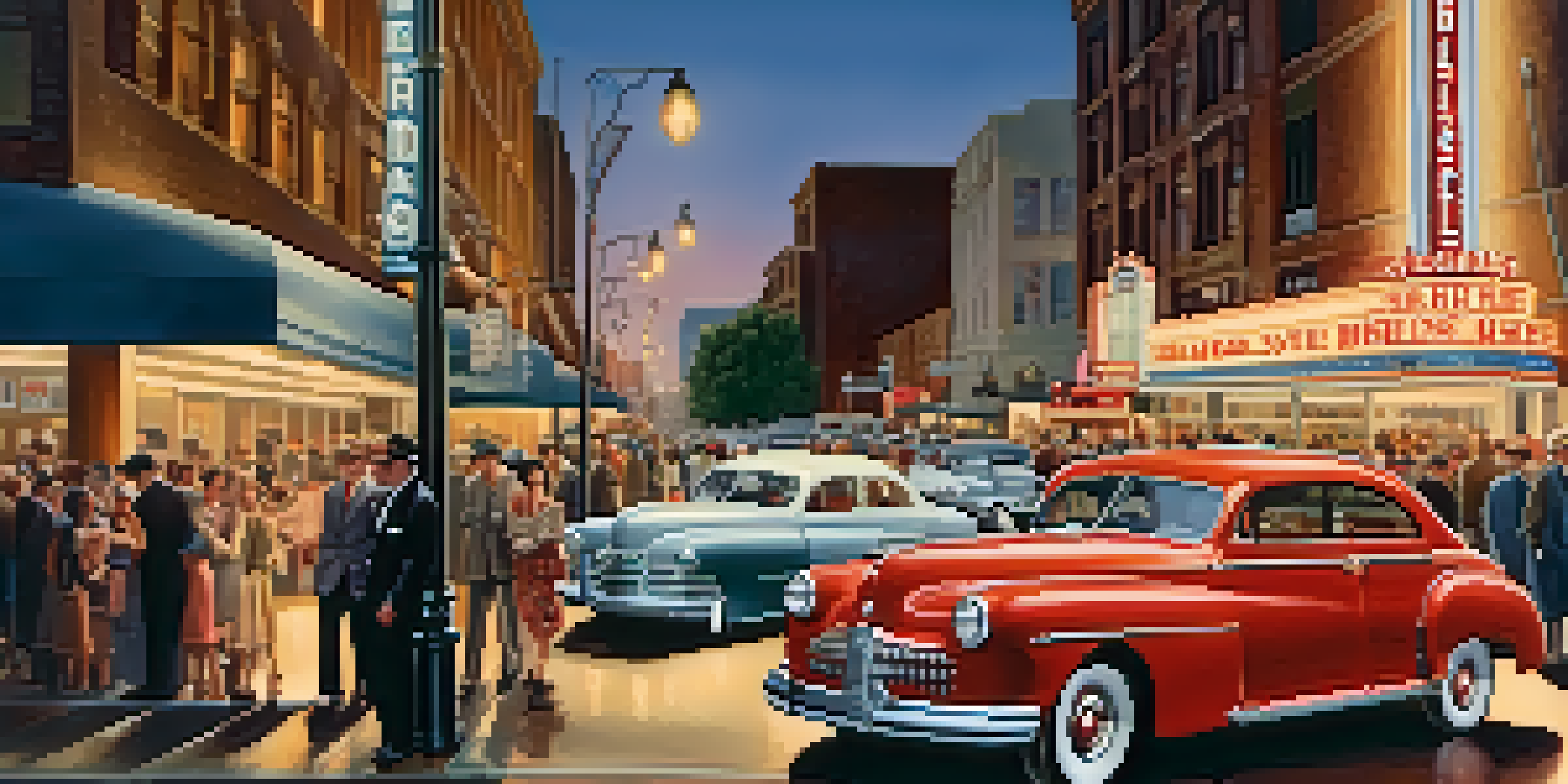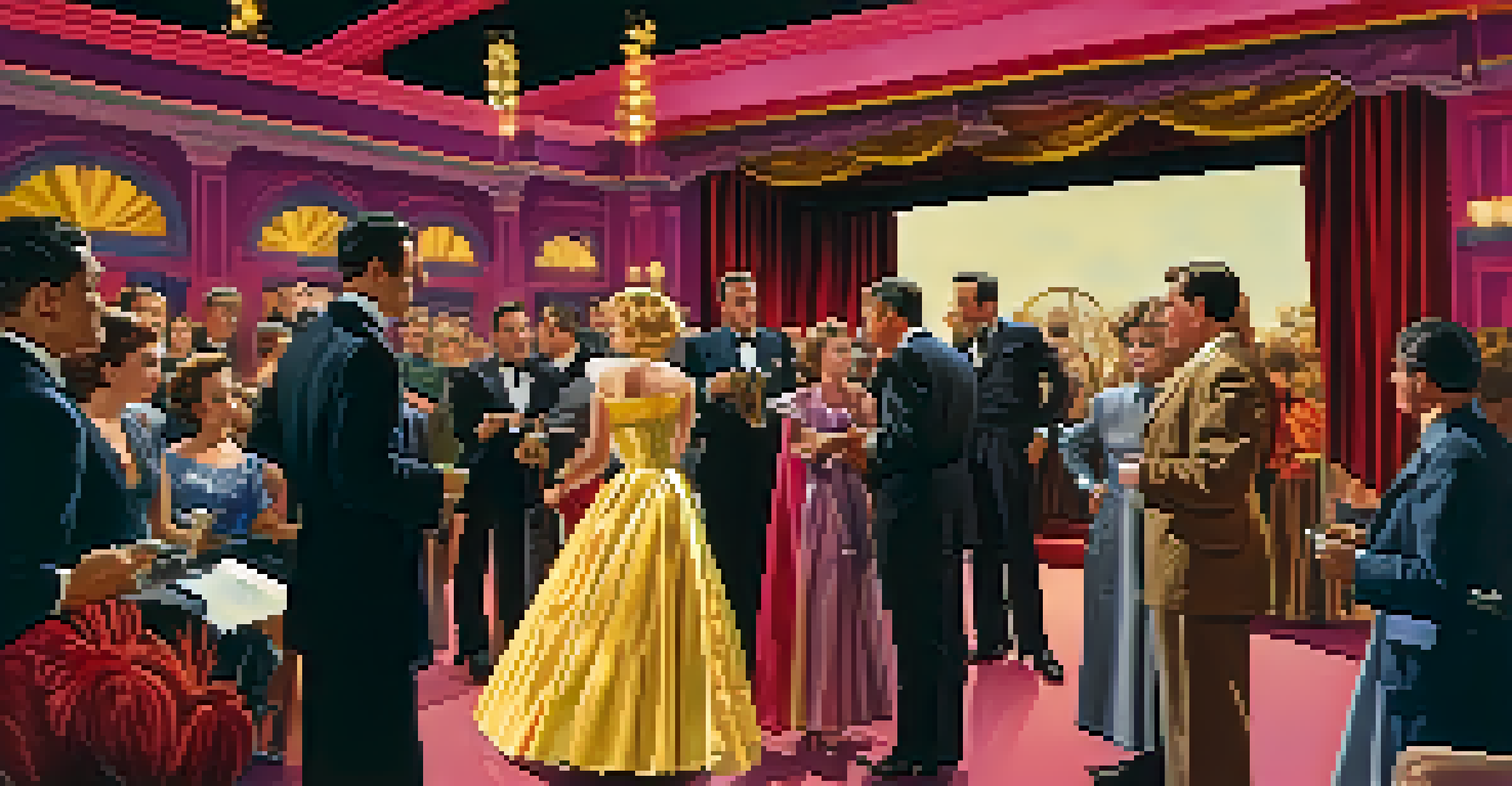Hollywood's Golden Age: Criticism and Its Cultural Impact

Defining Hollywood's Golden Age: A Brief Overview
Hollywood's Golden Age, spanning the 1920s to the 1960s, marked a transformative era in cinema. It was characterized by the rise of major film studios, the establishment of the star system, and the production of classic films that defined the American cultural landscape. During this time, films became not just entertainment but a powerful medium that reflected and shaped societal values and norms.
The movies are a little bit of a reflection of our society, and they can often be a mirror to our lives.
The Hollywood studio system created a production line of films that appealed to a broad audience, often prioritizing glamour and spectacle. Iconic films like 'Gone with the Wind' and 'Casablanca' emerged, showcasing not only cinematic innovation but also deep emotional narratives. This period also saw the introduction of sound in films, which revolutionized storytelling and audience engagement.
However, the Golden Age was not without its controversies. The industry's practices, including censorship and the portrayal of marginalized communities, sparked debates that would linger for decades. Understanding this era requires recognizing both its artistic achievements and the criticisms that paved the way for future reforms in Hollywood.
The Role of Criticism in Shaping Hollywood
Criticism during Hollywood's Golden Age played a pivotal role in both the evolution of film and the industry itself. Film critics began to emerge as influential voices, offering insights that could make or break a movie's success. Their reviews often highlighted the cultural relevance of films, prompting audiences to engage more thoughtfully with the content on screen.

Moreover, critics were instrumental in promoting artistic films that challenged mainstream conventions. Works like 'The Grapes of Wrath' and 'Citizen Kane' received both acclaim and critique, pushing boundaries and encouraging filmmakers to explore deeper themes. This interaction between critics and filmmakers fostered a more dynamic film culture.
Censorship Shaped Film Narratives
The Hays Code imposed strict guidelines that often sanitized complex issues, pushing filmmakers to use subtext and symbolism to convey deeper messages.
However, the impact of criticism was not always positive. Some critics were accused of elitism, favoring art films over popular genres. This tension continues to influence how films are received today, reminding us that the dialogue between critics and creators is essential for the growth of cinema.
Censorship and Its Impact on Creative Expression
Censorship was a significant factor during Hollywood's Golden Age, shaping the narratives and themes presented in films. The Hays Code, established in the early 1930s, imposed strict guidelines on content, dictating what could and could not be shown on screen. This often led to sanitized portrayals of complex issues, stifling the creative expression of filmmakers.
Cinema is a matter of what's in the frame and what's out.
Despite these restrictions, some filmmakers found innovative ways to convey deeper messages. Subtext and symbolism became crucial tools for directors and writers aiming to bypass censorship while still delivering powerful commentary. For instance, films like 'Double Indemnity' used film noir elements to explore themes of morality and betrayal.
The legacy of censorship can still be felt today, as modern filmmakers navigate the balance between artistic freedom and audience expectations. Understanding this historical context helps us appreciate the challenges artists faced and the ways they adapted to ensure their voices were heard.
Cultural Reflections: Hollywood vs. Reality
Hollywood's Golden Age was both a reflection of and an escape from the realities of American life. The glitz and glamour portrayed in films often masked the social issues of the time, such as racial inequality and economic hardship. While audiences found solace in the idealized versions of life on screen, the disconnect with reality raised important questions about the role of film in society.
Films like 'Guess Who's Coming to Dinner' began to tackle sensitive subjects, challenging audiences to confront their biases. These narratives highlighted the struggles of marginalized communities, pushing for social change while still entertaining a wide audience. This blend of entertainment and social commentary became a hallmark of the era.
Criticism Influenced Film Culture
Film critics emerged as influential voices during the Golden Age, promoting artistic films that challenged mainstream conventions and fostering a dynamic film culture.
The contrasting depictions of life in Hollywood and the real world continue to resonate today. As we analyze these films, we gain insight into the cultural dynamics of the time and the ongoing relevance of these narratives in our contemporary society.
The Star System: Fame and Its Consequences
The star system was a defining feature of Hollywood's Golden Age, creating larger-than-life personas that captivated audiences. Actors like Marilyn Monroe and Humphrey Bogart became symbols of glamour and allure, often overshadowing the collaborative nature of filmmaking. Their fame not only drew viewers but also shaped public perceptions of beauty and talent.
However, the pressures of stardom came with significant consequences. Many stars faced intense scrutiny and struggled with personal issues, often exacerbated by the public's unrealistic expectations. The darker side of fame, including addiction and mental health struggles, is a poignant reminder of the price of celebrity.
This duality of stardom — the allure and the burden — continues to influence how we view actors today. As audiences, we are drawn to their stories, but it's essential to remember the human beings behind the personas and the complexities that accompany fame.
Legacy of Hollywood's Golden Age in Modern Cinema
The legacy of Hollywood's Golden Age continues to shape modern cinema in profound ways. Filmmakers today draw inspiration from the storytelling techniques and visual styles established during this era. The influence of classic films can be seen in contemporary blockbusters, which often pay homage to the past while pushing the envelope of creativity.
Moreover, the themes explored during the Golden Age, such as love, loss, and social justice, remain relevant. Today's filmmakers often revisit these themes, reimagining them for a new generation while addressing current issues. This continuity demonstrates the timeless nature of storytelling and its power to reflect societal changes.
Star System Created Fame's Duality
The star system not only captivated audiences with larger-than-life personas but also highlighted the significant pressures and consequences of fame on actors.
As we look to the future, it's clear that the cultural impact of Hollywood's Golden Age will endure. By examining its critiques and accomplishments, we can appreciate the evolution of cinema and its role in shaping our cultural landscape.
Conclusion: Reflecting on the Golden Age's Cultural Significance
Hollywood's Golden Age was a complex period that fused artistic brilliance with societal critique. While celebrated for its cinematic achievements, it also faced significant criticism that prompted important discussions about representation and morality in film. This duality enriches our understanding of the era and its lasting impact on culture.
As we reflect on this time, it's essential to recognize the voices that challenged the status quo and paved the way for progress in the industry. The criticisms of the Golden Age laid the groundwork for the diverse and inclusive narratives we see in cinema today.

Ultimately, Hollywood's Golden Age teaches us that film is not just an art form but a reflection of our collective values, struggles, and aspirations. By engaging with its complexities, we honor its legacy while continuing to shape the future of storytelling.